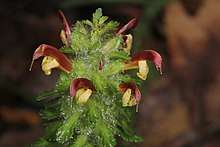Pedicularis canadensis
Pedicularis canadensis, commonly called Canadian lousewort[1] or wood betony,[2] is a flowering plant in the family Orobanchaceae.[3] It is native to North America, where it is found in southeastern Canada, the eastern United States, and eastern Mexico.[4][5] It has a wide-ranging natural habitat, being found in mesic to dry, forests, woodlands, and prairies.[6][7]
| Pedicularis canadensis | |
|---|---|
 | |
| Scientific classification | |
| Kingdom: | Plantae |
| Clade: | Tracheophytes |
| Clade: | Angiosperms |
| Clade: | Eudicots |
| Clade: | Asterids |
| Order: | Lamiales |
| Family: | Orobanchaceae |
| Genus: | Pedicularis |
| Species: | P. canadensis |
| Binomial name | |
| Pedicularis canadensis | |
Description

Pedicularis canadensis is a perennial, clonal, herbaceous plant, growing to 30 cm (12 in) tall.[7] It has long, soft, hairy leaves (many are basal, growing tufted from roots), some 12 to 36 cm (4.7 to 14.2 in) long, deeply incised and toothed, often reddish-purple under sunlight. It blooms in the spring to summer, between April and June.[8][9] It produces a broad whorl of tubular, hooded flowers on top of a segmented stalk. The flowers range in color from a greenish-yellow to purplish-red, clustered on short, dense spikes. They are pollinated by bumblebees. The fruit is a long brown seed capsule, which disperses through explosive dehiscence.[2]
Taxonomy
The genus name Pedicularis is from Latin meaning "of or relating to lice", from the belief that cows caught lice when grazing in pastures with the European Pedicularis palustris.[10] The specific epithet canadensis refers to Canada. It was formerly included in the family Scrophulariaceae but is now considered to be in Orobanchaceae.[10][11]
Two subspecies are accepted:[11]
- Pedicularis canadensis subsp. canadensis — broadly distributed
- Pedicularis canadensis subsp. fluviatilis (A.Heller) W.A.Weber — restricted to northern New Mexico and Colorado[12]
Distribution and habitat
Wood betony is broadly distributed across eastern North America, from Quebec east to Manitoba, south to Mexico, and east to Florida.[4][5] It occurs in a variety of habitats, including mesic to dry prairies, savannas, barrens, and woodlands.[6][10] In the Chicago area it is considered a conservative species, with a coefficient of conservatism of 9.[10]
Ecology
Pedicularis canadensis is a hemiparasite, attaching to the roots of diverse species, but also producing chlorophyll on its own.[13][14] Its roots also have a symbiotic relationship with a fungus that helps it gather nutrients.[15] It has been used in prairie restoration projects to reduce the dominance of aggressive tallgrasses.[16]
A leaf beetle, Capraita circumdata has been collected from inside of the flowers.[10] Several ants have been recorded visiting the flowers, including: Crematogaster cerasi, Formica incerta, Formica subsericea, and Lasius alienus.[10] Bees documented visiting the flowers of wood betony include Augochlorella aurata, Bombus auricomus, Bombus bimaculatus, Bombus fervidus, Bombus griseocollis, Bombus impatiens, Bombus vagans, Halictus confusus, and Lasioglossum anomalum.[10]
Uses
This plant was eaten by the Iroquois as a vegetable, often as a soup. It was added to oats and used as horse feed by Native Americans.
American Indians used a root infusion as a remedy for stomachaches, diarrhea, anemia and heart trouble and made a poultice for swellings, tumors and sore muscles.[17]
Folklore
The Menomini called the root "enticer root" and carried it as a charm when determined on seducing the opposite sex. The root was also used to heal broken marriages by placing it in food the couple would both eat, hoping its magic would rekindle romance.
References
- "Pedicularis canadensis". Natural Resources Conservation Service PLANTS Database. USDA. Retrieved 20 August 2018.
- Wood Betony (Pedicularis canadensis) U.S. Forest Service
- Stevens, P.F. (2001–2012), Angiosperm Phylogeny Website: Orobanchaceae
- "Pedicularis canadensis". County-level distribution map from the North American Plant Atlas (NAPA). Biota of North America Program (BONAP). 2014. Retrieved 20 August 2018.
- "Pedicularis canadensis L." www.gbif.org. Retrieved 2018-10-30.
- Alan Weakley (2015). "Flora of the Southern and Mid-Atlantic States".
- Yatskievych, George (2013). Flora of Missouri, Volume 3. Missouri Botanical Garden Press. p. 580.
- "Pedicularis canadensis (Canada wood betony): Plant Phenology". iNaturalist.org. Retrieved 2018-10-30.
- Connecticut Plants, Connecticut Botanical Society
- Wilhelm, Gerould; Rericha, Laura (2017). Flora of the Chicago Region: A Floristic and Ecological Synthesis. Indiana Academy of Sciences.
- "Pedicularis canadensis L.brevior". Plants of the World Online. Royal Botanical Gardens Kew. Retrieved 2018-09-28.
- "Pedicularis canadensis subsp. fluviatilis". Natural Resources Conservation Service PLANTS Database. USDA. Retrieved 2018-10-30.
- Hedberg, Andrew M.; Borowicz, Victoria A.; Armstrong, Joseph E. (2005). "Interactions between a Hemiparasitic Plant, Pedicularis canadensis L. (Orobanchaceae), and Members of a Tallgrass Prairie Community". The Journal of the Torrey Botanical Society. 132 (3): 401–410. doi:10.3159/1095-5674(2005)132[401:IBAHPP]2.0.CO;2. JSTOR 20063780.
- Gracie, Carol (2012). Spring Wildflowers of the Northeast. Princeton University Press. pp. 126–131. ISBN 978-0-691-14466-5.
- Horn, compiled and edited by Dennis Horn and Tavia Cathcart ; technical editor, Thomas E. Hemmerly ; photo editors, David Duhl and Dennis (2005). Wildflowers of Tennessee, the Ohio Valley, and the Southern Appalachians : the official field guide of the Tennessee Native Plant Society. [Edmonton]: Lone Pine Pub. p. 288. ISBN 978-1-55105-428-5.
- DiGiovanni, Jane P.; Wysocki, William P.; Burke, Sean V.; Duvall, Melvin R.; Barber, Nicholas A. (May 2017). "The role of hemiparasitic plants: influencing tallgrass prairie quality, diversity, and structure". Restoration Ecology. 25 (3): 405–413. doi:10.1111/rec.12446.
- Foster, Steven; Duke, James A. (1990). A Field Guide to Medicinal Plants and Herbs of Eastern and Central North America. United States of America: Houghton Mifflin. pp. 106. ISBN 978-0-395-46722-0.